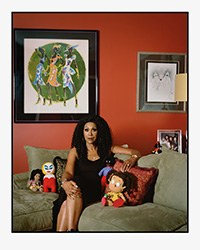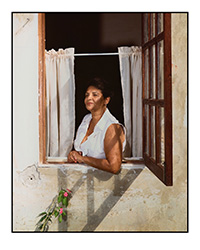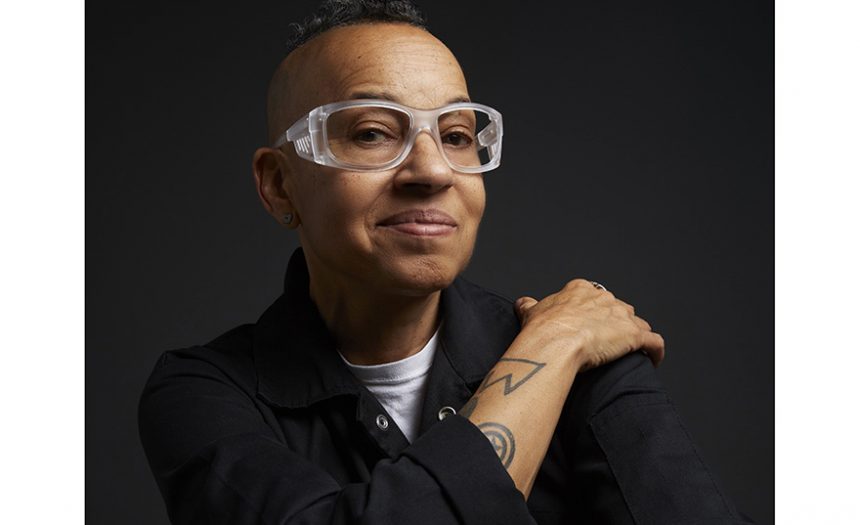Lola Flash, who prefers they/them pronouns, is a pioneering portrait photographer whose work challenges gender norms and explores LGBTQIA+ and communities of color. Raised in Montclair, New Jersey, Lola discovered their passion for photography at a young age.
Their impactful photography is featured in prestigious collections such as the Museum of Modern Art and the National Museum of African American History and Culture. In 2023, Lola’s book Believable: The Portraits of Lola Flash was recognized as one of the top photo books of the year by Smithsonian.
Recently, Senior Planet had the opportunity to speak with Lola Flash, the 65-year-old Manhattan-based photographer.
Early Life
SP: How did you first become interested in photography?
LF: My journey into photography began when my mom’s boyfriend gifted me a Minox camera. This sparked my interest in capturing the world around me. As I delved deeper, I transitioned to a 35mm camera in high school, eventually leading me to realize that photography would be my lifelong passion. Initially drawn to scientific photography, I later shifted my focus to fine arts photography to explore themes of identity.
SP: What inspired you to document the queer community and LGBTQ individuals through your photography?
LF: I see my photography not as mere documentation, but as a form of love and activism within my community. By showcasing individuals who are often overlooked, I aim to challenge societal biases and amplify marginalized voices. Through my lens, I redefine beauty beyond traditional norms depicted in mainstream media.
SP: Your early work reflects a strong political undertone. Was this influenced by your involvement with ACT UP?
LF: Being Black and gay inherently makes one political. Even simple acts like displaying affection are seen as political statements. Participating in ACT UP during a pivotal period of my life allowed me to merge photography with activism. The AIDS crisis united us and fueled my commitment to use photography as a tool for social change.
Artistic Development
SP: Did your iconic Cross Colour style emerge during this period?
LF: My work surrounding the AIDS crisis heavily featured the Cross Colour technique, where I manipulated colors to subvert narratives. This visual approach continued for two decades before evolving into more traditional color portraits around 2000. Each series I undertake explores different themes like race or age.
SP: What drives your satisfaction in creating such profound work?
LF: I find fulfillment in capturing individuals who radiate positive energy and pride in their identities. Photography serves as my medium to celebrate these resilient souls, especially within communities that are often marginalized. It’s a way for me to impart lessons and empower viewers.
SP: Can you share about your SALT project and the inspiration behind photographing older women?

LF: The SALT project is my homage to the influential women in my life – my mother and grandmother. By capturing older women in their spaces, I aim to showcase their resilience and beauty that often goes unnoticed. This collaborative series allows these women to dictate their environments, highlighting their regal and dignified presence.

Continuing this project until I reach 70, I intend to conclude with a self-portrait, encapsulating the essence of the series.
SP: What does “aging with attitude” mean to you?
LF: Embracing aging with attitude involves how I present myself and engage with the world. Drawing inspiration from diverse friendships and experiences, I navigate life with vibrancy and curiosity. By connecting with people from various backgrounds, I cultivate a deeper understanding and appreciation for humanity.
Photo credit for headshot of Flash: Christa Holka.
Photo credit for Insets
Inset Left photo of Ruth: Lola Flash
Inset right photo of Maria: Lola Flash

Kate Walter is a well-respected author known for her memoirs and poignant essays. Her work has been featured in renowned publications, showcasing her talent for storytelling and social commentary.
Photo of Kate Walter by Su Zen






